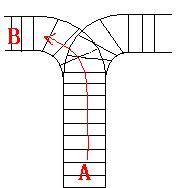原题:http://acm.hdu.edu.cn/showproblem.php?pid=1022
Train Problem I
Time Limit: 2000/1000 MS (Java/Others) Memory Limit: 65536/32768 K (Java/Others)
Total Submission(s): 18882 Accepted Submission(s): 7099
Problem Description
As the new term comes, the Ignatius Train Station is very busy nowadays. A lot of student want to get back to school by train(because the trains in the Ignatius Train Station is the fastest all over the world ^v^). But here comes a problem, there is only one railway where all the trains stop. So all the trains come in from one side and get out from the other side. For this problem, if train A gets into the railway first, and then train B gets into the railway before train A leaves, train A can't leave until train B leaves. The pictures below figure out the problem. Now the problem for you is, there are at most 9 trains in the station, all the trains has an ID(numbered from 1 to n), the trains get into the railway in an order O1, your task is to determine whether the trains can get out in an order O2.






Input
The input contains several test cases. Each test case consists of an integer, the number of trains, and two strings, the order of the trains come in:O1, and the order of the trains leave:O2. The input is terminated by the end of file. More details in the Sample Input.
Output
The output contains a string "No." if you can't exchange O2 to O1, or you should output a line contains "Yes.", and then output your way in exchanging the order(you should output "in" for a train getting into the railway, and "out" for a train getting out of the railway). Print a line contains "FINISH" after each test case. More details in the Sample Output.
Sample Input
3 123 321
3 123 312
Sample Output
Yes.
in
in
in
out
out
out
FINISH
No.
FINISH
For the first Sample Input, we let train 1 get in, then train 2 and train 3.
So now train 3 is at the top of the railway, so train 3 can leave first, then train 2 and train 1.
In the second Sample input, we should let train 3 leave first, so we have to let train 1 get in, then train 2 and train 3.
Now we can let train 3 leave.
But after that we can't let train 1 leave before train 2, because train 2 is at the top of the railway at the moment.
So we output "No.".
Hint
Hint其实关于这道题呢,难度还比上解析四则运算。我这里给大家分享下解题过程。火车进出站问题一般都要涉及到栈结构。本质就是进入过程能否和出去过程匹配的问题。分别把进入过程和出去过程放在两个数组。然后对进入过程设置指针p1,出去过程设置指针p2,如果p1==0,那么p1指向的车厢进入栈,如果p!=0;询问下栈顶元素和p2指向的车厢是否相等,相等就用while() pop();p2++;一直到栈为空或者stack.top()!=p2指向的车厢;一直到p1指到超过了最末尾车厢;“in”和“out可以在每次对栈结构操作时(pop()=>out,push()=>in),存放在一个string类型的数组里卖,最后如果栈是空的表示能够按照给你的出战顺序实现,那么输出Yes.步骤呢只要按照格式输出数组中的所有元素就可以了。如果栈不是空的,那就不行就输出No.
代码如下:
#include<iostream>
#include<stack>
#include<string>
using namespace std;
int main(){
int count;
while(cin>>count){
char num1[9],num2[9];
string op[100];
stack<char> st;
int j=0;
int p=0;
int cp=0;
for(int i=0;i<count;i++){
cin>>num1[i];
}
for(int i=0;i<count;i++){
cin>>num2[i];
}
while(p<=count){
if(!st.empty()){
if(st.top()==num2[j]){
while(!st.empty()&&st.top()==num2[j]){
st.pop();
op[cp++]="out";
j++;
}
if(p==count){
break;
}
}else{
st.push(num1[p++]);
op[cp++]="in";
}
}else{
st.push(num1[p++]);
op[cp++]="in";
}
}
if(!st.empty()){
cout<<"No."<<endl;
cout<<"FINISH"<<endl;
}else{
cout<<"Yes."<<endl;
for(int a=0;a<cp;a++){
cout<<op[a]<<endl;
}
cout<<"FINISH"<<endl;
}
}
return 0;
}






相关推荐
ACM HDU 2000->2099 解题报告 ACM HDU 2000->2099 解题报告 ACM HDU 2000->2099 解题报告
HDU 1010-2500解题报告,ACMer可以借鉴一下
hdu2000-2014ac代码,虽然只有几道,但都是简单的
ACM入门的课件适合于那些想要学习的ACM,提高自己编程能力的。
hdu-acm源代码(上百题)hdu-acm源代码、hdu-acm源代码hdu-acm源代码
杭州电子科技大学online judge (hdu)第十一卷 2000 - 2099 题目集 doc 格式的,希望大家喜欢!
解题报告|ACM|程序设计参考程序以及题目的分析
ACM题库,一些题目和答案,以及解题报告,传上来共享
ACM程序设计题目分析以及AC的源码
最精准的答案(本人做对的题目拿上来给大家呈现)!不要忘记是C++编的
杭电OnlineJudge 200-2099的解题报告
我去年暑假花了5天,把杭电ACM网站上2000到2099这100道题全AC了,又花了10来天精心写解题报告。 里面包括题目、解题思路、编程技巧以及参考源码。所有代码都是使用C/C++写的。 最近整理资料时无意间发现,打包...
HDU 1022 Train Problem I 附详细思路
HDU的1250,主要是利用高精度加法,但是代码有点繁琐,效率不是很高
有题,有解题思路,有解题代码 hdu2516、poj1067和hdu1527、hdu2177、hdu2176等等
算法-数塔(HDU-2084).rar
HDU 里面的2000~2099道题目的源码。谢谢支持